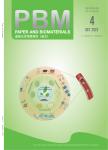Green Modification of Cellulose Nanocrystals and Their Reinforcement in Nanocomposites of Polylactic Acid
Green Modification of Cellulose Nanocrystals and Their Reinforcement in Nanocomposites of Polylactic Acid作者机构:Jiangsu Engineering and Technology Research Center for Functional Textiles Jiangnan University Key Laboratory of Eco-textiles of Ministry of Education School of Textile and Clothing Jiangnan University State Key Laboratory of Pulp and Paper Engineering South China University of Technology Department of Forest Biomaterials College of Natural Resources North Carolina State University
出 版 物:《Paper And Biomaterials》 (造纸与生物质材料(英文))
年 卷 期:2018年第3卷第4期
页 面:10-18页
学科分类:0202[经济学-应用经济学] 02[经济学] 081703[工学-生物化工] 020205[经济学-产业经济学] 08[工学] 0817[工学-化学工程与技术] 0836[工学-生物工程]
基 金:the National Natural Science Foundation of China (grant Nos. 31570578 and 31270632) the Fundamental Research Funds for the Central Universities (grant No. JUSRP51622A) the State Key Laboratory of Pulp and Paper Engineering (grant No. 201809)
主 题:cellulose nanocrystals thermal stability hydrophilicity polylactic acid compatibility nanocomposites
摘 要:Cellulose nanocrystals (CNCs) of rod-like shape were prepared from degreased cotton using sulfuric acid hydrolysis. The obtained CNC suspension was neutralized using a sodium hydroxide solution to remove the residual sulfuric acid and improve the thermal stability of the CNC particles. Then, poly(ethylene oxide) (PEO) was employed to modify the nanocrystals through entanglement and physical adsorption. The goal was to further improve the thermal stability and weaken the hydrophilicity of CNCs. Original and modifed CNCs were dosed into a polylactic acid (PLA) matrix to prepare nanocomposites using a hot compression process. Results of the thermogravimetric analysis showed that the initial thermal decomposition temperature of the modifed CNCs showed a 120℃ improvement compared to the original CNCs. That is, the thermal stability of the modified CNCs improved because of their shielding and wrapping by a PEO layer on their surface. Results from scanning electron microscopy and ultraviolet-visible spectrophotometry showed that the compatibility of the modifed CNCs with organic PLA improved, which was attributed to the compatibility of the PEO chains adsorbed on the surface of the CNCs. Finally, the results of tensile tests indicated a significant improvement in terms of breaking strength and elongation at the break point.



